A century ago, the establishment of a U.S.-UK challenge, the British American Cup (“BAC”) brought with it a golden age of innovative racing keelboat design. In our 2021 Conversations with Classic Boats series on the development of the Six Metre, we marked the BAC as an inflection point in modern yacht racing.
The BAC was a challenge in 1921: You designed a boat to the International Six Metre rule (then virtually unknown in the U.S.). Each side fielded four boats. You alternated venues: Cowes on the Isle of Wight and Oyster Bay on the north shore of Long Island. The first country to win two matches in succession would take permanent possession of the Cup. The BAC lit a fire under Anglo-U.S. keelboat competition. This early 1920s photo shows a procession of Six Metres on the Solent.
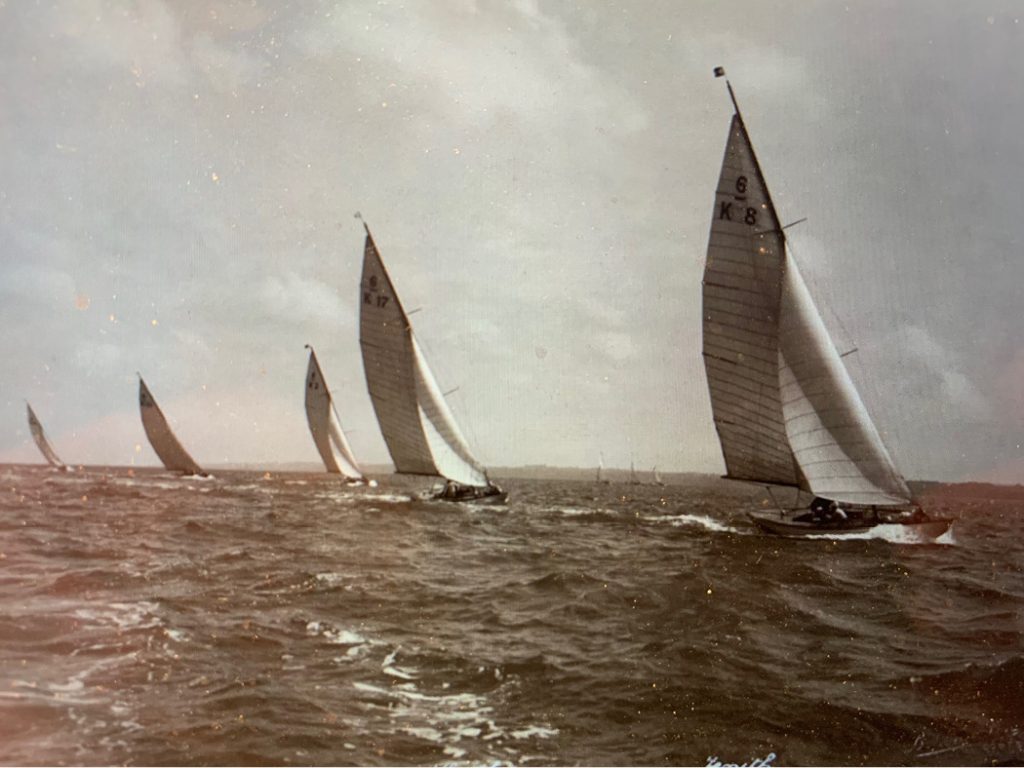
The four American boats in that initial BAC were Jean and Sakie, from the firm of Burgess and Paine, and the William Gardner-designed Montauk and Grebe. The U.S. side, sailing in unfamiliar waters in the Solent, absorbed a 117 to 88 loss from the British quartet. Drake Sparkman (Olin Stephens’ partner) summed it up in his article “Fifteen Years of the Six Metres” in a 1936 edition of Yachting:
“Not a very auspicious beginning in some respects, but from another point of view not at all disappointing considering our unfamiliarity with the rule.”
He continued: “A return match was scheduled for Oyster Bay in 1922 and the interest aroused by the inauguration of the British American Cup series was reflected in the rush to build boats to try for places on the American Team. No less than thirteen Sixes were built in this country in 1922, the greatest number in any single season in the history of the class.”
“In this boom year ten different designers went to work. Sidney Herreshoff, Charles D Mower, Clinton H. Crane, Addison G. Hanan, Frederick M. Hoyt, W. Starling Burgess, Frank C Paine, C. Sherman Hoyt and John Alden toiled over their boards. Nevins, Wood, Lawley, Herreshoff and Jacob put their best boat builders to work.”
“With the country’s ranking designers drawing the plans, the nation’s best boat builders practicing their craft in the all important matter of construction, the best sailmakers exerting their skill and imagination, and the most eminent small boat skippers handling the finished product, it is small wonder that the class has flourished.”
And so started one of the most intense periods of boat development in U.S. yachting history. From four boats in 1921, new fewer than sixty-five Sixes were racing by 1936. Fifty-eight of those were designed and built by Americans. Seawanhaka Corinthian Yacht Club was the epicenter of that activity. It was design, build, and sail to survive for the first BAC in U.S. waters, conducted from Oyster Bay. Sparkman, in his 1936 article, amplified on that:
“The credit for introducing the Six Metres in this country and their early development obviously belongs to the Seawanhaka Corinthian YC. Its energetic sponsoring of international small boat racing started things and kept them going. The more recent history of the class reveals how diligently Seawanhaka has kept the light burning, even during the darkest depression years. With the building of Lanai from a Clinton Crane design by a Seawanhaka syndicate in 1925, a new era began in American Six Metre racing. Lanai was an unqualified success…”
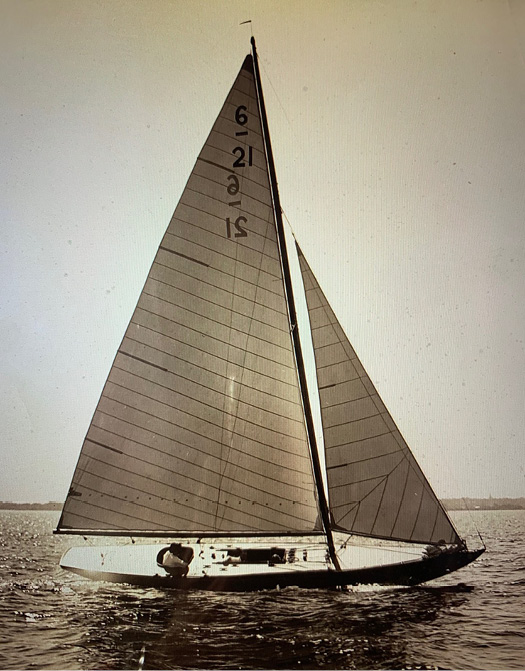
Nee Warlock in 1921, now Madcap
The Sixes Game was on. Designer, builder, driver, owner—they were the marine equivalent of Grand Prix auto racing teams up to World War II.
The earliest example of this outburst of innovation spends summers floating off the SCYC launch dock. Hugh Jones’ 1924 contender Warlock sits prettily, reminding us all of this epic keelboat heritage. Warlock’s designer was Frederick Hoyt, an architect well represented in the early 1920s competition. Hoyt had just happened to survive the sinking of the Titanic in 1912.
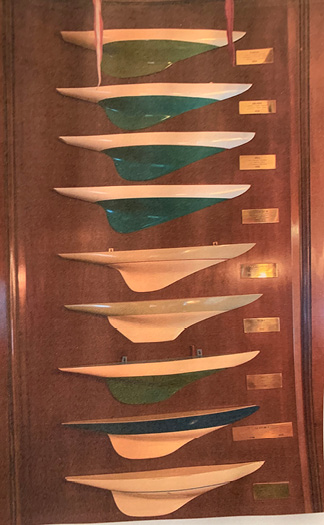 The exquisite Edwardian bar at Seawanhaka contains a stunning collection of Sixes models, including a ceiling to floor display of half models of the most famous boats, evidence of the club’s dedication to the class.
The exquisite Edwardian bar at Seawanhaka contains a stunning collection of Sixes models, including a ceiling to floor display of half models of the most famous boats, evidence of the club’s dedication to the class.
Starting chronologically in the 1920s at top, this photo depicts a decade of innovative naval architecture. On top is Lanai, Clinton Crane’s prototype for future designs like Brooks Cunningham’s Lucie. Next is Akaba (1927) Crane’s next design and Brooks Cunningham’s first Six, renamed for his bride to be, Lucie I. From that point on the wall, with the exception of two Luders designs of 1932 and 1934 (Rebel and Challenge; cool gray boats with the trademark Luders sheer and sharp ends), the rest of the models are from the design office of Sparkman & Stephens.
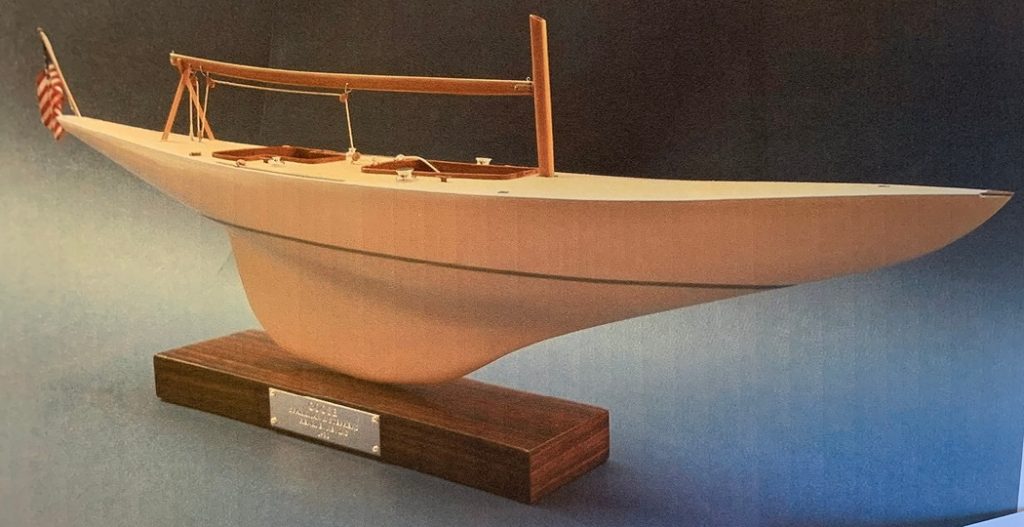
That lineup includes Jill (1930), built for the Havemeyers (the sugar family) and BobKat II (1931), for the Meyers. At the bottom of the stack is the trio that confirmed Stephens’ fame as the foremost designer of Sixes. Djin (1938) was a medalist at the Olympics as late as 1952 (the last Games for the Sixes).
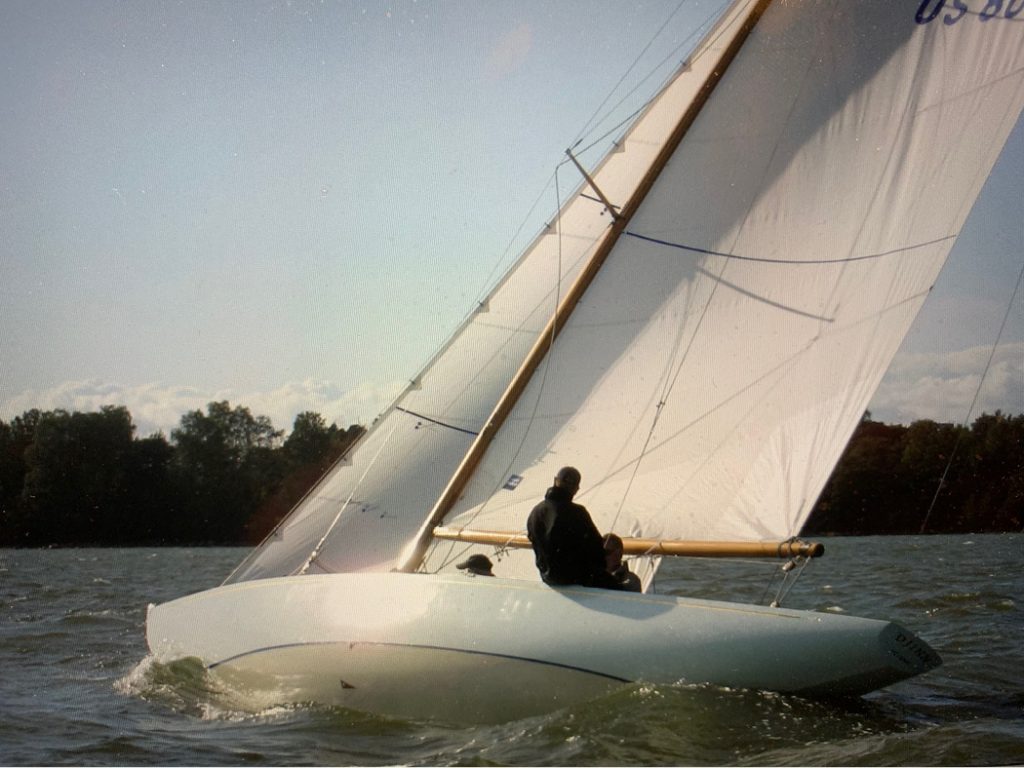
Djin, Olin Stephens’ post-war design, derived from Goose.
Stephens’ gem, Goose, pictured above, first sailed in 1938 before being disassembled (her original stern adorns the Seawanhaka dining room wall) and subsequently rebuilt to be the winningest Six in history. Llanoria was built a decade later in 1948 for Herman “Swede” Whiton, the godfather of the modern Six Metre and its progeny, the 5.5 Metre. She is a boat still active, with two Olympic Gold medals won in 1948 and 1952. The photo does not do justice to the three dimensional grace of these models.
America’s dominance in the Six Metre class tracked with the rise of one young designer who left MIT in 1926 with a mission to design fast boats. That was Olin Stephens and the Six Metre was his weapon of choice on the water. In his autobiography he explained, “I started my career with the tools of observation and intuition to which quantitative analysis has been gradually added. Wherever possible I studied lines and tried to see the way shape was coupled to performance…” His first design, Ghost, appeared in the January 1928 edition of Yachting, and from there the Sixes flowed.
In 1929, Stephens set up an office with Drake Sparkman, a successful broker, on City Island in the Bronx, New York. It was Herman F. Whiton who in 1930 collaborated with Stephens to produce Cherokee, Olin’s breakthrough design and the first Six to carry a big parachute spinnaker.
British yachting writers dubbed it the beginning of “the Stephens era,” “where the American amateur crews displayed marked superiority over the British who were depending on ‘conservative paid hands.’ After squeaking out a win in the BAC in 1930, the American Six Metre teams did not lose another contest in that decade.”
It is the string of Stephens designs that came to be in the 1930s that have lived on in design fame. Aside from the wall of trophies at Seawanhaka and photographs from international competitions including the BAC, the Seawanhaka Cup and the Gold Cup, where is the evidence of these elegant grand prix yachts measuring from 36 to 43 feet long, with cramped cockpits and acres of sail? Where did these finely tuned, gorgeous craft go?
My cousin Peter Taylor, a photographer, and I set out to find out. Peter broke the story first. We found on the other side of the continent, in the Pacific Northwest, across Puget Sound from Seattle, on Bainbridge Island, in a boatyard and anchorage that smells of old wood and canvas, the private collection of Peter Hofmann, amassed with the help of his father Harry Hofmann. The Hofmanns are the curators of Sixes back to 1931’s Saga and forward to the S & S trio of 1938-48.
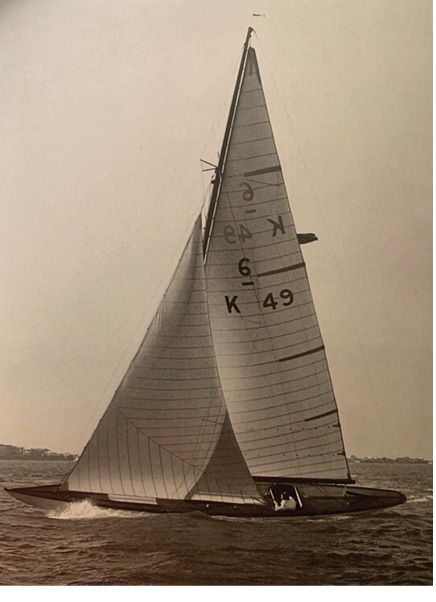
Saga was the inspiration for the International One Design. Courtesy of the Peter Taylor collection
The Hofmanns preserve this cache, the original designs, floating or cradled in the most unique depository of boats that we know. From the San Juan Islands down to Seattle, the tradition of wooden boats is as strong today as is in venues like Midcoast Maine, but nowhere have we discovered a living museum of a class like the International Six Metre.
What is the Seattle collection and where is it? Most sail under the flag of the Port Madison Yacht Club. First, Saga, the early 1930s Norwegian design from Bermuda that caught Corny Shields, Sr.’s eye and led to the commissioning of the International One Design for fleets at Larchmont, Marblehead and Bermuda. Saga has been owned by PMYC member Kimo MacKey for three decades. We saw Saga covered and floating at the dock on Bainbridge. Shields would ask for a taller rig and more ballast for the Long Island Sound model that debuted in 1935.
The IOD would see upwards of 250 boats built in wood and since the 1970s in fiberglass, and will enjoy its 87th year of competition this September in Nantucket.
Next in the Hoffman collection is Goose, built in 1938, alleged to be the fastest Olin Stephens Six Metre built before World War II. Accounts of late 1930s racing, in the days when sailboat racing was on the front page of the newspapers’ sports section, feature Goose in her many victories. To my eye, the Goose profile was in Olin Stephan’s mind when he drew the Shields as the 1960s replacement for Larchmont Yacht Club’s aging IOD fleet.
And finally, the immortal Llanoria, her inexplicable name given by owner Herman “Swede” Whiton, set the post-war speed standard when the Olympics still featured the 6 Metre. It was Whiton who won the most medals for an American in Olympic sailing and led the transition to the 5.5 Metre from the 6 Metre, which had been the queen of the Olympic fleet since 1908.
Hoffman has a longing for bringing these later S&S Sixes up to fighting trim. He already has a well restored Elizabeth X, originally from the mid-1930s, which he lent a sister ship, May Be VII, to Dennis Conner for the 2017 Six Metre Worlds. Llanoria is almost as race ready and is a classic with her very own web presence.
After giving Peter the guided tour, Hofmann directed him to Seattle’s Wooden Boat Center, a mecca for lovers of the smaller wood race boat. It was there that Peter found the circa 1920s Uffa Fox International 14 that we featured in the March 2023 WindCheck story on Uffa Fox and Bruce Kirby, “Planing Pioneers.” Wooden classics are everywhere.
The thoroughbred design of American keelboats, the International Six Metre was the training ground for skippers who would jump into the new America’s Cup 12 Metre Class in 1958. Name the skippers – they trained on the Sixes and their one-design relative, the International One Design.
We have dedicated enthusiasts like Peter Hofmann in Seattle to thank for keeping these boats alive to be seen and even raced. Llanoria, Goose and Saga, like Ferrari, Mercedes-Benz and Aston Martin, are synonymous with performance at a high level.
And we are learning about the history of other lost fleets of Sixes. One was at Gibson Island on the west shore of the Chesapeake, before World War II. We understand as many as half a dozen, including well-known boats like Indian Scout and BobKat, were sailing there. Look for your Sixes and report, wherever you are. ■
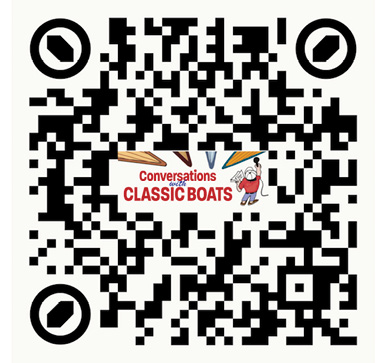
Scan to tune into the author’s Conversations with Classic Boats podcast.
Tom Darling is the host of Conversations with Classic Boats, “the podcast that talks to boats.” Tune in via Apple Podcast, Google Podcast or Spotify, or online at conversationswithclassicboats.com.




